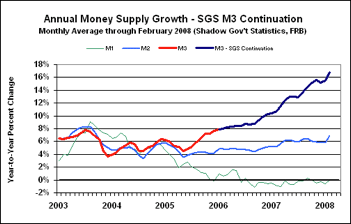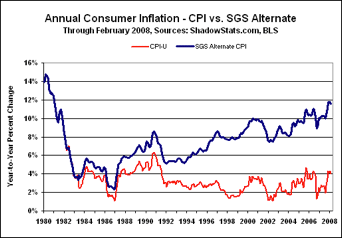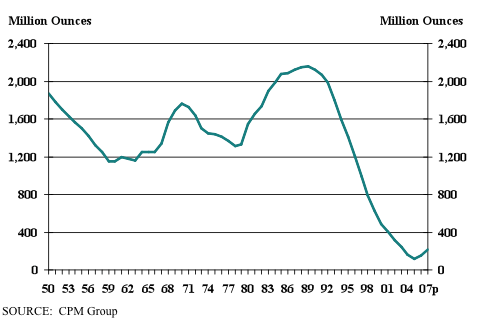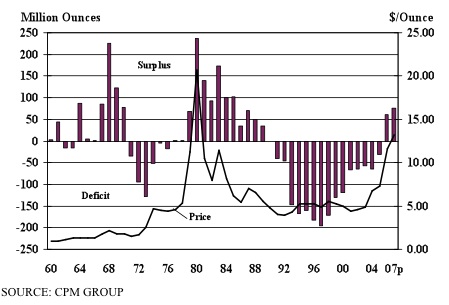Precious Metals Bull to Continue: Silver to be a Star Performer
Thursday, March 20, 2008
by Jared Irish of Archer Financial Services
insidefutures.com
With the Fed bailing out the credit crisis and the dollar breaking new lows, investors must decide what allocations should be made in precious metals. Gold and silver have been used as the money of choice for millenniums. Given the fiat currency system we are currently in, they offer protection against inflation and government induced debasement of currencies.
With the recent run up in prices above $1000 per ounce in gold and $21 in silver, investors should be concerned about the potential for a large break in the precious metals market. Although the potential for a correction exists, the underlying fundamentals and inflationary pressures indicate we will likely see the bull-run in precious metals stronger than ever. Monetary expansion, the energy crisis, threat of war, and the currency crisis are likely to become more prevalent in the years ahead. Furthermore, demand continues to outpace supply. Precious metals continue to offer the opportunity to protect and profit from inflation. When it comes to the decision on which metal will outperform the other, most investors are clueless. I believe that silver should be the star performer in the coming years.
One of the best predictors of the future is history. Over the past millennium we have seen about four inflationary waves occurring about every 200 years. The history of inflationary eras shows us that these inflationary cycles have a common identifiable characteristic and sequence of events. We saw similar changes in wages, rent, interest rates, and increased volatility in the markets. These inflationary periods began in with population increases and times of prosperity. This was followed by an increased need for food, shelter, energy, and the basics necessities of life. These periods also had massive declines in production and employment. They all ended in a severe crisis.
Governments have always found a way to control the value of money to the detriment of the average citizen. Today they use cyberspace to expand credit and the money supply. In the past they used coin clipping or a debasement of the gold and silver content. History shows us that, when governments are given the power to control the value of money, the currency eventually fails.
According to Economists John Williams of www.shadowstats.com, the M3 monetary expansion is currently at 16% and climbing.

Inflation is far worse than the Fed’s numbers would like the public to believe. Economists John Williams of Shadow Stats estimates the true rate of inflation to be at 11 percent.

Supply and Demand:
It is not just inflationary problems that have created the Bull Run in metals. Supply and demand is stronger than ever. According to the GFMS, a precious metals research and consulting firm, silver demand has outpaced supply for over 15 years. Silver supply deficits have ran, on average, over 87 million ounces annually over this time period. This has depleted silver inventories, pushing them to historic lows.

In the graph below, surpluses represent investors buying more silver and deficits represent investors selling silver into the market on a net basis. Surpluses usually correlate to rising prices when they first emerge and are expanding. Later, when surpluses persist but begin to decline, prices begin to fall. As you can see in the chart below, the deficits that occurred throughout the 1990’s were close to 5 times larger than they were in the inflationary period of the 1970’s. The characteristics and similarities between these time periods, leads me to believe that the current run in silver in should surpass the 1980 highs of $48 an ounce.

Vital Uses for Silver:
One primary difference between gold and that of silver is its industrial use. Given the technological age we live in, we continue to find new uses for silver. One of the most important developments is the use of silver as a superconductor to produce a range of products which increase the electrical grid capacity and reliability by as much as 30 percent. We have all heard about the electricity crisis that is beginning to occur around the world. With the soaring demand and the deterioration of existing electrical infrastructure, this is one area that should do well regardless of whether you believe we are in a recession or not. The Silver Institute estimates that this application could take as much as 50 million ounces of silver annually. It could also help out the gold and platinum mines in South Africa as their electricity crisis is enlightened.
ETF Demand and Investor Demand:
The size of the precious metals market is a small fraction in comparison to the stock and bond markets. But investors around the world are beginning to enter into the silver market. As this trend continues, the already bullish market will begin to accelerate. Exchange Traded Funds are already holding over 200 million ounces.
Silver Mined as Byproduct:
Another primary difference between gold and silver is the fact that about 75% of silver comes as a byproduct from other large base metal producers. If we were to move into an economic slump, these firms may slow production causing further deterioration in the supply of silver.
Silver for Profit:
The Fed’s actions to bail out the credit crisis will only delay the problem sending us further into the inflationary cycle. The silver market is rather small in comparison to the gold market, and precious metals are only a fraction of the size of traditional asset markets. We are in a supply crunch as investment demand and new industrial uses increase. The likely prospects for silver are higher. I would recommend taking positions for December 2008 contracts using a bear put spread to hedge based on your risk tolerance. While both gold and silver will perform well, silver is expected to yield higher returns.
If you have interest in discussing opportunities in these markets you may call me at 877-377-7936 or email me at jared.irish@archerfinancials.com
I am also have a limited number of free books entitled “The Age of Inflation: Continued” by Hans Sennholz. Please call me at 877-377-7936 to receive your copy.
Futures and options trading involve significant risk of loss and may not be suitable for everyone. Therefore, carefully consider whether such trading is suitable for you in light of your financial condition. The views and opinions expressed in this letter are those of the author and do not reflect the views of ADM Investor Services, Inc. or its staff. The information provided is designed to assist in your analysis and evaluation of the futures and options markets. However, any decisions you may make to buy, sell or hold a futures or options position on such research are entirely your own and not in any way deemed to be endorsed by or attributed to ADMIS. Copyright © ADM Investor Services, Inc. |








